“As launch windows open and close, the next missions move forward. Two test flights of the lunar landing vehicle, and then the proposed landing on the Moon. And plans are in the making now which include fly-bys of other planets; visits to what Dr. Bunche calls neighbors.” – From Debrief: Apollo 8, a NASA promotional film circa 1968
Just a few weeks ago, NASA Administrator Charlie Bolden boldly unveiled the agency’s new vision: “Imagine trips to Mars that take weeks instead of nearly a year, people fanning out across the inner solar system, exploring the moon, asteroids and Mars nearly simultaneously in a steady stream of firsts.” (“Launching a Broader Vision for NASA,” Los Angeles Times, February 2, 2010)
Yeah, and then imagine visiting a distant moon populated by ten-foot-tall blue people, which is slightly more plausible than NASA’s grandiose dreams.
Bolden’s ambitious proclamation was intended to put a positive spin on NASA’s acknowledgment that the Constellation Program, which President George W. Jetson had promised was going to put us back on the Moon by 2020, was being canceled. I’m sure we would have made it though were it not for the fact that President Blackbush doesn’t seem to want to fund the effort. Sure, he increased the agency’s budget for 2011, but he didn’t, you know, increase it enough. So the Constellation Program, which taxpayers have already reportedly shelled out at least $9,000,000,000 for, and which will reportedly cost another $2,500,000,000 to cancel, has been tossed on the scrap heap.
According to Bolden, things weren’t really going all that well anyway: “Currently, [Bolden] said, the 5-year-old Constellation program is burning through billions of dollars and falling further behind schedule. The program couldn’t get American astronauts back to the moon until at least 2028 … ‘So as much as we would not like it to be the case … the truth is that we were not on a path to get back to the moon’s surface,’ Bolden said.”
Well, were we at least on a path to put together a better simulation of landing on the Moon?
Taking into account that the Constellation Program was begun in 2005, and that the Apollo program allegedly landed men on the Moon in a mere eight years, it would appear that it wouldn’t actually take twice as long to get back to the Moon with today’s technology, as previously advertised, but would actually take at least three times as long! If, that is, we were able to man-up and follow through with the plan, which obviously isn’t going to happen.
But be assured that that’s only because we don’t have the money. Otherwise, we totally would have made it back to the Moon. Possibly in less than twenty years. By which time all the technology that we know and love today will be as obsolete as pagers and Betamax video recorders, and trips to the Moon will still be something that we only talk about – sometimes nostalgically, as we fondly recall the fabled glory days from a decade few will remember, and sometimes with an eye to the future, a oft-promised future that never seems to arrive.
In May of 1966, after spending five years working on the Apollo project, we were just a-year-and-a-half away from the launch of the first Saturn V. In 2010, after spending five years working on the Constellation project, NASA has nothing to present to us but a hefty bill – which just goes to show that lack of technological sophistication and space-flight experience can apparently be easily overcome with a little determination … and a couple rolls of duct tape.
I was thinking, by the way, that if the idea of an Apollo reenactment were properly pitched to the right ‘reality television’ producers, we could probably make it back to the Moon in just a year or so. There was quite a bit of Apollo hardware that was left over after the sudden demise of the program, much of which is now in various aerospace museums – and aerospace museums tend to be run by aerospace geeks who would like nothing more than to see the U.S. triumphantly return to the Moon. It shouldn’t be that hard then to convince them to donate that hardware for it to be put to use for the purpose it was originally intended to serve.
We’re going to need to assemble all our donated hardware, of course, and for that we can turn to the guys at Monster Garage, who should be able to slap it together for us in a couple of afternoons. There will undoubtedly be some missing and/or non-operational parts, but that shouldn’t slow things down much; we can just give the guys over at American Pickers a call and they’ll scour America’s backroads to find the parts we need, or reasonable facsimiles. Once our reconstituted Saturn V rocketship is launch-ready, we’ll need to select a crew, and the most obvious choice, needless to say, would be Bear Grylls and his cameramen, with the Moonwalk footage broadcast as a special edition of Man vs Moon.
Unlike girlie-men like Neil Armstrong and Buzz Aldrin, Bear would undoubtedly show us a few tricks that the Apollo gang never thought of – like fashioning a shelter out of Moon rocks, foraging for the food and water that others failed to find, building a roaring fire despite the lack of both air and combustible materials, and finding several new and creative uses for the urine bags that his predecessors tossed aside as space trash. He could also probably design and build his own lunar rover from parts salvaged from artifacts of the Soviet Luna program. And he could probably do it all without the need for a spacesuit.
Speaking of spacesuits, just a week before NASA shit-canned the Constellation Program, the agency announced that it had awarded a contract to Oceaneering International and the David Clark Company to design and build a brand-new, state-of-the-art spacesuit for use on future manned missions to the Moon and beyond (“NASA’s Next Space Suit,” Technology Review, January 25, 2010).
“If NASA returns to the moon in 2020 as planned, astronauts will step out in a brand-new space suit. It will give them new mobility and flexibility on the lunar surface while still protecting them from its harsh environment … The space agency has awarded a $500 million, 6.5-year contract for the design and development of the Constellation space suit.” Astronauts performing EVAs these days currently use something known as the Extravehicular Mobility Unit: “It has a hard upper torso, layers of material to protect astronauts from micrometeoroids and radiation, a temperature-regulation system, and its own life support and communication system. The EMU weighs over 300 pounds and has limited leg mobility – astronauts feet are normally locked in place on foot restraints while performing extravehicular tasks, and during Apollo missions, which used a different EMU suit, astronauts were forced to develop a bunny hop to traverse the lunar surface.”
I could, of course, point out once again the absurdity of it taking about four times as long to develop a spacesuit now than it did back in the hi-tech 1960s, but I’m pretty sure I’ve already beat that particular horse damn near to death and then rubbed salt in the wounds. I could also point out that the Apollo suits somehow managed to perform all the duties of the current EMUs while weighing about 40% less, but that’s also already taken a pretty severe beating.
So instead, I’ll focus on the contention that the Apollo astronauts were “forced to develop a bunny hop to traverse the lunar surface,” which, as an alert reader pointed out, flies in the face of numerous past claims in which it was maintained that the ‘bunny hop’ was found to be the most effective means of locomoting in a reduced gravity environment, not that it was something forced upon the astronauts by the limitations of the spacesuits. If I remember correctly, one of the Mythbusters propagandists claimed that he had verified that it was the most efficient means of moving in reduced gravity, and he was, by his own admission, wearing a costume and not a pressurized spacesuit when he conducted his experiment.
Someone, it would appear, is doing a little lying here. I am, needless to say, as shocked as all of you.
“‘When we went to the moon the first time, we were just trying to get there. Now astronauts need to be able to explore the surface, harvest resources, and do science,’ says Daniel Barry, vice president and director of research and development at David Clark Company, and head of the Constellation space suits project.”
So the Apollo missions, it turns out, were just about getting there. And the reason, I guess, why we allegedly flew men to the Moon eight times (including the alleged fly-bys by Apollo 8 and Apollo 13) was to, uhmm, prove that getting therethe first time was no fluke. Sure, we were told that the boys were sent there to “do science” and that they took along a bunch of scientific testing equipment – and even, on the last flight, an actual scientist – but that apparently wasn’t really the case. And the lunar rovers allegedly flown to the Moon were not brought along to enable the astronauts to “explore the surface” and conduct additional science projects.
This time, however, we’re going to do it right … in another 20+ years, that is … if we fast-track it.
What “resources,” by the way, are we planning to “harvest”? We’ve already allegedly brought back numerous samples of Moon rocks, which appears to be about the only resource readily available, other than the water NASA now claims can be found there. How much does it suck, by the way, for NASA to have to cancel the Constellation Program right after the agency had reported allegedly discovering loads of water on the Moon?
One ‘debunker’ claim that has been made fairly frequently over the years, it should be noted, is that NASA’s alleged Moon rocks contain no traces of water, proving that they are not of Earthly origin and could only have come from the surface of a waterless sphere like the Moon … which isn’t, NASA now claims, waterless. I have no doubt though that those same ‘debunkers’ will be able to come up with some convoluted, hackneyed explanation for the apparent discrepancy.
Pictured below is the evolution of the American spacesuit. From left to right in the top row are the Mercury suit (1961), the Gemini suit (1965), and the pre-Playtex Apollo suit (1968); in the lower row are the famous Apollo magic suit (1969), the first space shuttle suit (1981), and the new suit being produced for the now-defunct Constellation Program. Below that, believe it or not, is an early prototype Apollo suit. While it may appear to be a still from some 1950s sci-fi flick, or a computer generated artist’s conception, it is, in fact, an actual suit being tested in the Mojave Desert in the mid-1960s. It is probably safe to assume that it didn’t pass the test.
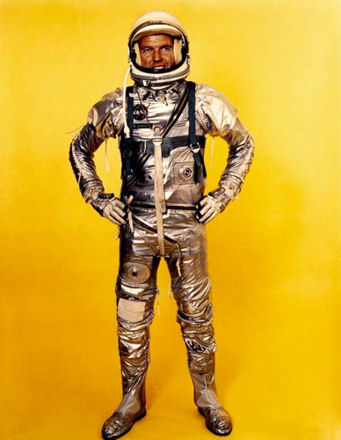
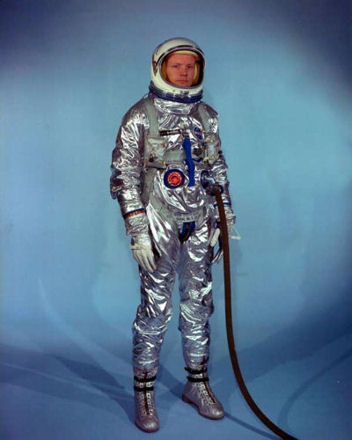

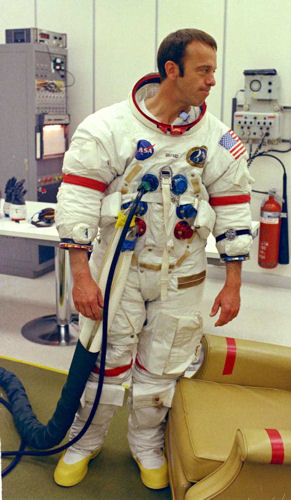

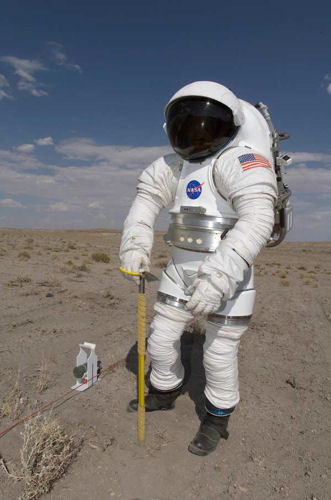
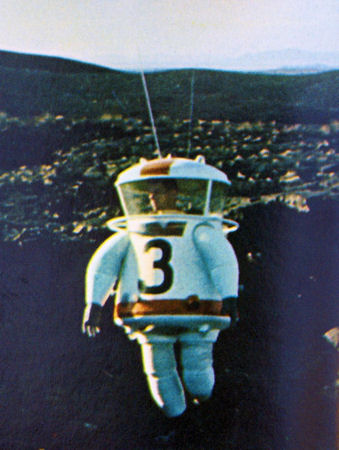
Another thing Bear Grylls would undoubtedly do is bring us back some of those dazzling lunar starscapes that the Apollo guys neglected to capture. Presented below, by the way, is one of NASA’s former astronomy pics of the day. It carried with it the following explanation: “If you could turn off the atmosphere’s ability to scatter overwhelming sunlight, today’s daytime sky might look something like this.” Below that is a shot from deep space, illustrating that stars in outer space maybe aren’t really as camera-shy as some would like us to believe.


According to Bolden, NASA had “focused so much of our effort and funding on just getting to the moon, we were neglecting investments … required to go beyond.” So while we don’t have the money required to get back to the Moon, you see, we do have the money to bypass the Moon and fly our guys to more distant locales, like Mars. No target date has been set, but I’m guessing that if we focus our attention on these bolder objectives, we’ll probably succeed by, like, 2050. Or maybe 2060. Or 2069, on the 100th anniversary of the first alleged Moon landing.
As will be recalled, we set our sights a little higher in the 1960s. When Kennedy delivered his famous declaration back in May of 1961 that we were going to the Moon, he gave the aerospace community less than a decade to make it happen. Engineers across the country, who were well aware of the fact that the nation hadn’t even taken its first baby-steps yet, were understandably dismayed.
The first Apollo contract was awarded just two months later, in July of 1961, for the sophisticated navigation system that would allegedly guide the spacecraft to the Moon. In an unusual move, NASA opted not to solicit bids for the guidance system; instead, the contract was handed directly to MIT, generating “immediate controversy,” as noted by Moon Machines. As one of the show’s talking-heads noted, “There was actually a budding industry out there that had developed guidance systems and people from industry were quite upset. They felt that they should have been given the chance to bid on the contract – and a university is not ordinarily what the government contracts out to build hardware for operational systems.”
There was, alas, nothing ordinary about the Apollo project.
The man NASA turned to first, long before awarding any of the other Apollo contracts, was one Charles Draper, who ran MIT’s instrumentation lab, which would later carry Draper’s name. Draper was generally described as an eccentric, charismatic, colorful gent whose background was in physics and, curiously, psychology. He is widely considered to be the father of the inertial guidance system.
Perhaps significantly, Bill Kaysing, the first Apollo skeptic to gain prominence, has claimed that it was MIT (in conjunction with DARPA) that provided NASA with the blueprint for how to plausibly simulate manned trips to the Moon. If true, then it of course makes perfect sense that NASA would have turned directly and immediately to MIT, and would have done so without taking any outside bids. Until MIT completed their work and provided the space agency with an outline of the project, it would seem, NASA wouldn’t have known what other contracts to award.
The fact that the project landed on the desk of Charles Draper is perhaps significant, given that the name ‘Draper’ is a rather notorious one in twentieth century American history – and one that is closely tied to the name ‘Bush.’ It is a name that appears more than once on the membership list of everyone’s favorite secret society, Skull & Bones (Herbert Draper Gallaudet [1898], Arthur Draper [1937], William Draper III [1950]). It is a name that was prominently featured in the American eugenics movement, with General William Draper, Jr. serving as founder and chairman of the Population Crisis Committee and vice-chairman of the Birth Control League (as Planned Parenthood was originally known). General Draper, a close friend of the Bush family, also helped finance the 1932 International Eugenics Conference. Many years later, during the Apollo era, Draper advised LBJ on population reduction strategies.
The Draper family was also, not too shockingly, involved in the financing and maintenance of the Nazi regime. General Draper joined Dillon Read in 1927 and for many years was tasked with personally handling the account of Nazi industrialist/financier Fritz Thyssen. At the close of WWII, Draper was appointed Chief of the Economic Division of the Joint Allied Control Council for Germany – he was, in other words, the man who was supposed to oversee the economic de-Nazification of Germany. Just months later, in October 1945, Draper reported that the German economy had magically been de-Nazified. Needless to say, nothing could have been further from the truth.
One final note about General Draper (whose son, Bonesman William Draper III, served as the chief of fundraising for George Bush’s 1980 presidential campaign): he was a member of the Society of American Magicians. In other words, William Draper, Jr. considered himself to be something of an expert in the art of illusion. Perhaps the same could be said of Charles Draper of MIT.
According to Moon Machines, Draper and his team got to work on the Apollo guidance system in the spring of 1962. Given that Moon Machines also contends that the contract was awarded to MIT in early summer of 1961, the question that is naturally begged is: why, with the clock ticking and with an absurdly short timeframe to pull the Apollo project together, would the MIT team have waited almost a year to get started? Or did they, in fact, spend that first year working on their real assignment – mapping out the key elements of the simulation?
If so, then they apparently spent a fair amount of time viewing an obscure German silent film by the name of Die Frau im Mond (The Woman in the Moon), as noted in the painfully long documentary, What Happened on the Moon? The German feature film, released by filmmaker Fritz Lang in 1929, provided the blueprint for the heavily ritualized launch procedures that were adopted for the Apollo program. As can be seen in the screen caps below, all of the elements were there: the unnecessary vertical construction of the spaceship in a specially built hangar; the grand opening of the massive hangar doors; the excruciatingly slow roll-out of the upright rocketship from the hangar to the launch pad; the raucous crowds watching the spectacle live; the now ubiquitous countdown; even the shedding of two stages of the ship. In other words, the only elements of the performance that the public ever actually witnessed were all lifted directly from a forty-year-old silent film.

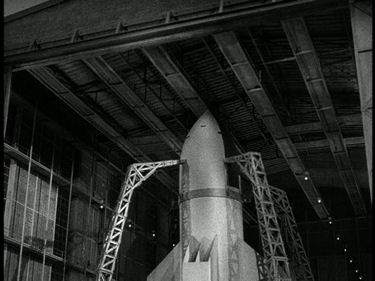


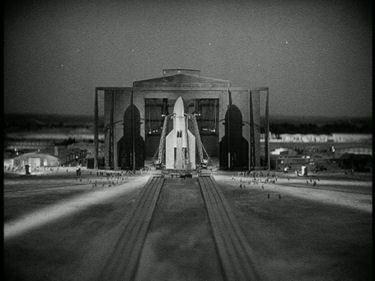

Fritz Lang’s technical adviser on the film was Herman Oberth, considered to be one of the three founding fathers of rocketry. Assisting Oberth on the film project, according to the previously quoted Time-Life book To the Moon, was one of his brightest students, nineteen-year-old Wernher von Braun. A decade-and-a-half later, both Oberth and von Braun would be scooped up through the Paperclip project and brought to America to work on, among other things, the Apollo program, whose choreography just happened to very closely match that of the fake Moon launch Oberth and von Braun had crafted forty years earlier.
Die Frau im Mond, by the way, was not the only Fritz Lang film that proved to be rather prophetic. He followed it up in 1931 with M, the tale of a sadistic, pedophilic serial killer guided by voices in his head. I wonder how he came up with that plotline?
Before moving on, I should probably point out here yet another brazen lie the ‘debunkers’ like to tell – the one that holds that von Braun was only a Nazi because he had little choice in the matter, what with living and working in Germany during the days of the Third Reich and all. That’s a nice little fable, to be sure, but it is contradicted in a big way by at least one known photograph in which von Braun can be seen adorned in the elite Nazi regalia of the Black Order of the SS. As anyone who has studied the Nazi hierarchy is well aware, Himmler’s elite order had a ‘no weekend Nazis need apply’ policy.

Anyway, returning to MIT, the starting point for engineers was to develop a gyroscope-based guidance system. The problem though was that gyros could not be produced to MIT’s exacting standards, resulting in gyro after gyro being rejected. Another problem was that translating data from the gyros into flight instructions would require, as Moon Machines noted, a “modern digital computer,” and putting such a beast in a spaceship “was an entirely new challenge.”
“Computers in the early 1960s,” you see, “were huge. The idea of squeezing such a monster into a spacecraft seemed preposterous.” But that wasn’t really going to be a problem since, as we have already seen, clearing seemingly insurmountable obstacles was something that the aerospace community was uniquely skilled at in the 1960s. The engineers working on the onboard computer utilized an entirely new technology known as the silicon chip. The technology was so new though that no one knew what it could actually do. And as with the gyros, it proved to be nearly impossible to produce chips of acceptable quality.
At the time, ‘software’ was a virtually unknown concept. As Moon Machines duly reported, “With nobody clear on exactly what the computer should do, the software engineers were free to write almost anything they liked.” One of those flight software developers, Alex Kosmala, made the following remarkable admission: “There were no specs. We made it up. Uhmm … and it’s always [been] amazing to me – why was I allowed to program something that hadn’t even been specified [but] that would be critical in assuring the success of the whole Apollo Program? I couldn’t believe it, but that’s the way it was. We made it up as we went along!”
I’m going to take a wild guess here and say that NASA probably wasn’t unduly concerned since the functioning of the software would only have mattered if the agency was planning to actually send guys to the Moon.
The most complicated aspect of the Apollo missions was the landing of the lunar modules, which made the software program controlling that part of the mission the most difficult to design. Amazingly though, that aspect of the software design was not assigned until after most of the other programs were 2/3 complete – and it was assigned to a twenty-two-year-old gent named Don Isles who had just recently started his very first job. According to Moon Machines, “the program without which it would be impossible to land on the Moon … had been written almost as an afterthought by a junior engineer.”
It is rumored that MIT first tried to pawn the job off on a kid who flipped burgers at the local McDonalds, but he apparently had prior commitments.
By mid-1966, Draper’s dream of controlling the entire mission via an onboard computer had been dropped in favor of an Earth-based control system with the Draper system along as back-up. MIT allegedly produced a computer the size of a small fridge, which both the command module and the lunar module were outfitted with. Despite the overwhelming obstacles faced by the MIT team, and the seemingly lackadaisical approach taken with the project, the Apollo guidance system, as would be expected, performed nearly flawlessly on every outing.
One final note here on Die Frau im Mond before wrapping up this installment: the gatekeepers over at the BAUT forum appear to be in on the joke. Why else would the site’s logo contain not an image of NASA’s lunar module sitting on the surface of the Moon, but rather a rocketship that looks suspiciously like the spaceship from Lang’s film?

In 1965 Fritz Lang, along with his technical adviser Willy Ley, gave an interview which is very interesting, because, they make fun of Wernher von Braun and his vision. In my opinion it seems that Fritz Lang was hired by NASA to do some “work”. He was an experienced film director and he was certainly able to create a second “silent film”of a rocket ship that lands on the moon by courtesy of NASA.
Fritz Lang: ›Walt Disney once made a TV documentary on rocket ships, and asked me permission to insert my scene of the rocket launch. The launch scene used a small plastic model. Experts from Cape Kennedy asked me a few months ago to come for a talk on rocket ships, and they recognized me as their elder. During 1948, I tried to convince some major studios to make a film with rocket ships, a film of immediate future, in which rockets have not yet reached the moon. I didn’t manage to convince any of them, and I believe they had some regrets, much later, to have missed such a commercially certain idea.‹
Willy Ley: ›With today’s technology, we can go to the moons of Jupiter. Not in five or six years, but today.‹ –
Fritz Lang: ›Who said that?‹
Willy Ley: ›Wernher (von Braun) said it. I am 95 % certain about the rocket to Mars.‹
Fritz Lang: ›Put the television on, perhaps that news is already on.‹
Willy Ley: ›Not yet. In three months we’ll know.‹